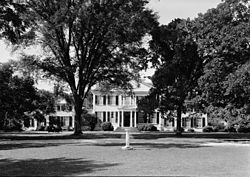Wye House
|
Wye House
|
|

Wye House mansion, seen from the front lawn
|
|
| Nearest city | Easton, Maryland |
|---|---|
| Built | 1781 |
| Architect | Key,Robert |
| Architectural style | Georgian, Federal |
| NRHP Reference # | 70000264 |
| Significant dates | |
| Added to NRHP | April 15, 1970 |
| Designated NHL | April 15, 1970 |
Wye House is a historic plantation house northwest of Easton in rural Talbot County, Maryland. Built in 1781-84, it is a high-quality and well-proportioned example of a wooden-frame Southern plantation house. It was designated a National Historic Landmark in 1970.
The Wye plantation was settled in the 1650s by a Welsh Puritan and wealthy planter, Edward Lloyd. Between 1780 and 1790, the main house was built by his great-great-grandson, Edward Lloyd IV. It is cited as an example between the transition of Georgian and Federal architecture, which is attributed to builder Robert Key. Nearby the house is an orangery, a rare survival of an early garden structure where orange and lemon trees were cultivated, and which still contains its original 18th century heating system of hot air ducts.
During its peak, the plantation surrounding the house encompassed 42,000 acres (17,000 ha) and housed over 1,000 slaves. Though the land has shrunk to 1,300 acres (530 ha) today, it is still owned by the descendants of Edward Lloyd, now in their 11th generation on the property. Frederick Douglass spent a few years of his life on the plantation, around the ages of seven and eight, and spoke extensively of the brutal conditions of the plantation in his autobiography, Narrative of the Life of Frederick Douglass, an American Slave.
The nearby hamlets of Unionville and Copperville are where many descendents of the slaves who worked Wye House live today. This has created an interesting dynamic, considering the descendents of both the slave owners and the slaves still live within a very short distance of one another.
...
Wikipedia


